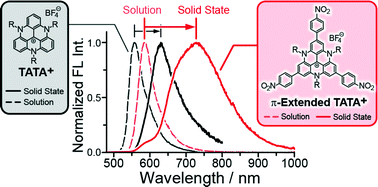Fluorescence behavior of 2,6,10-trisubstituted 4,8,12-triazatriangulene cations in solution and in the solid state†
Abstract
Triazatriangulenium (TATA+) is a cationic aromatic dye with C3 symmetry, which shows an isolated absorption and emission band at the visible region (λmax,FL = 558 nm, fluorescence quantum yield Φf = 0.25). A number of TATA derivatives have been reported until now; however, substitution at the 2-, 6-, and 10-positions has not been adequately investigated yet. In this work, we synthesized TATA derivatives having various substituents at the 2-, 6-, and 10-positions and investigated their photophysical properties in solution and in the solid state. The emission wavelength was red-shifted by ca. 25 nm in the solution phase when a 4-nitrophenyl group was directly introduced into the TATA framework (λmax,FL = 585 nm, Φf = 0.17). The emission band was further red-shifted by ca. 140 nm in the solid state and a near-infrared (NIR) emission was observed (λmax,FL = 728 nm, Φf = 0.008). Analysis based on the radiative (kf) and non-radiative (knr) rate constants suggests that the substituent effect on Φf in the solution phase is mainly attributed to the change in the knr value. On the other hand, the strong fluorescence quenching in the solid state is attributed to the decrease of the kf value, suggesting that intermolecular interactions in the solid state become prominent when the π-conjugation system of the TATA framework is extended by direct functionalization.

- This article is part of the themed collection: Solid-State Photochemistry

 Please wait while we load your content...
Please wait while we load your content...